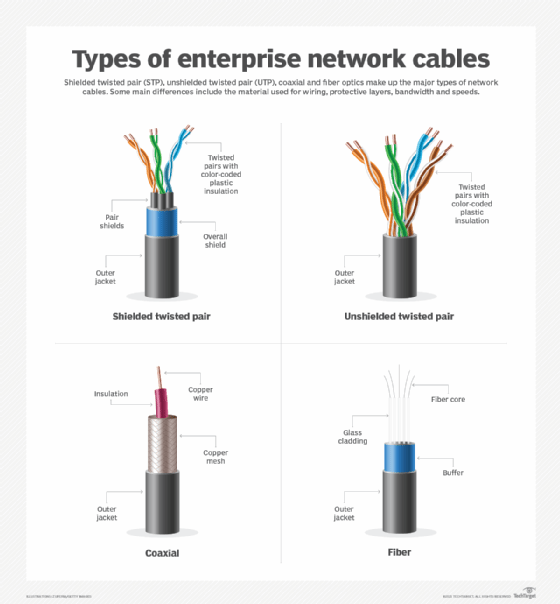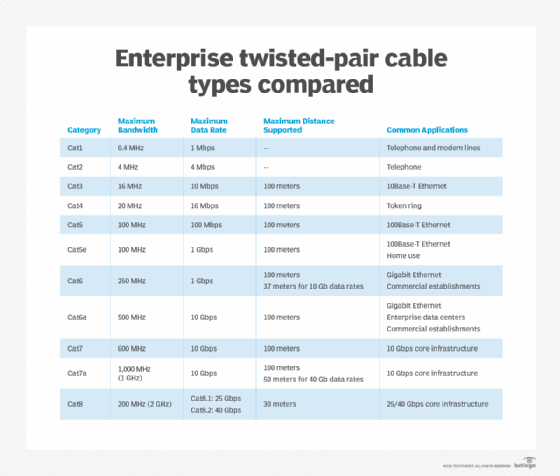Categories of twisted-pair cabling systems
What are categories of twisted-pair cabling systems?
A twisted-pair cabling system is a cable consisting of one or several pairs of copper wires. These wires are twisted together and around each other and are insulated with a dielectric polymeric compound. Twisting helps minimize electromagnetic radiation and resists external interference. It also helps limit interference with adjacent twisted-pair cables.
Twisted-pair cables were among the earliest guided transmission media, along with coaxial cables. Today, twisted-pair cables are used in many applications in networking and communication, for example, in telephone lines, Digital Subscriber Line and local area networks.
More about twisted-pair cables
A twisted-pair cable simply refers to a cable in which pairs -- one or more -- of insulated strands of copper wire are twisted around one another. In the pair, one wire is used to transmit data, and the other is the ground reference.
These cables can be used in bus topologies, where the cable is laid out as a single line and passes through all stations, as well as in star topologies, where each computer or terminal is connected by a single twisted-pair cable to a central hub.
Two types of copper conductors may be used in twisted-pair cable:
- Solid. A solid conductor twisted-pair cable, with a single strand of copper, offers better transmission performance over long distances, making it suitable for use in permanent lines and backbone cabling with the use of an insulation displacement connector, or IDC.
- Stranded. A twisted-pair cable with stranded wiring consists of multiple smaller wires woven together. It has high signal attenuation, which limits its performance distance. That is why it is usually used only in patch cord production for local connections.
Twisted-pair cable categories
Twisted-pair cables are of two types:
- Unshielded twisted pair (UTP). These cables generally comprise wires and insulators.
- Shielded twisted pair (STP). These cables come with a braided, wired mesh that encases each pair of insulated copper wires.

Unshielded twisted pair
As the name suggests, a UTP cable has no internal shielding. The UTP cable is the most common twisted-pair cable used in Ethernet networks. It also is used for traditional telephone (UTP-Cat1) systems.
UTP cables are popular all over the world due to their low cost, ease of installation and flexibility. They also support high data transfer speeds of up to 1 gigabit per second (Gbps) for transmission distances of up to 100 meters (m). These cables are also easy to expand and troubleshoot.
One crucial drawback of UTP is that it is vulnerable to signal interference, which can affect output quality. Moreover, it is not suitable for long-distance transmissions. To support distances longer than 100 m, repeaters are required.
Shielded twisted pair
STP cables include a shielding, usually made of aluminum foil, around the conductors to isolate the conductors and improve the cables' resistance to noise and signal interference. One drawback is that STP cables are more difficult to connect at termination points. Also, STP cables are more expensive than UTP cables. Nonetheless, they prevent signal interference better than UTP cables, so their additional cost can be worth it, depending on the application.
Shielded cables support data transfer rates of 10 to 100 megabits per second (Mbps). They are best suited for transmission distances of up to 100 m.
Why is there twisting in twisted-pair cables?
To prevent noise, signal interference and crosstalk during transmissions, twisting is introduced into conducting cables. Twisting reduces the strength of noise signals and cancels out external waves by moving a part of the noise in the direction of the signal and another part in the opposite direction. Since the receiver can calculate the voltage difference of two wires to retrieve data more efficiently, twisting provides better noise immunity and lower signal attenuation.
Categories of twisted-pair cabling systems based on rated speeds
According to the International Organization for Standardization/International Electrotechnical Commission 11801 standard, cable names also follow a certain format: XX/XXX.
Here, the first two X's -- sometimes just one X -- refer to the cable shielding:
- unshielded (U)
- foil (F)
- braid screen (S)
- braid screen plus foil (SF)
The third X refers to the shielding of each pair. So, U means unshielded, and F means foil.
The last two X's simply mean that the cable is a twisted pair. Thus, F/UTP, for example, represents foil shielding on the cable itself, and UTP indicates the pairs are unshielded.
The standard also defines the following classes for twisted-pair cables:
- Class A
- Class B
- Class C
- Class D
- Class E
- Class EA
- Class F
- Class FA
Higher-class cables -- for example, Class FA -- provide a higher transmission rate than classes such as A and B.
The American National Standards Institute/Electronic Industries Alliance (ANSI/EIA) does not use a class-based system to categorize twisted-pair cables. Per this system, all cabling systems are categorized in terms of the data rates -- maximum bandwidth -- that they can effectively sustain. The specifications describe the cable material and the types of connectors and junction blocks used to conform to a defined category.
Also, ANSI/EIA is one of several standards that specify categories -- the singular is commonly known as a Cat -- of twisted-pair cabling systems, such as wires, junctions and connectors. These categories are described below.

Cat1
This UTP cable supports a maximum data rate of 1 Mbps. It was primarily designed for analog voice communications and is not suitable for networking applications.
Cat2
This category was used in IBM token ring networks in the 1980s. It is capable of voice and data communications, although it is not commonly used now on high-speed networks.
Cat3
This category was introduced in the early 1990s and is currently used in telephone wiring. It consists of four twisted pairs and was the first to support 10Base-T Ethernet networks and digital communications. The cable is not considered suitable for modern networking since it only supports data transmission rates of up to 10 Mbps.
Cat4
Like Cat3, Cat4 cables are also typically found in older buildings. Originally, it was used in IBM token ring networks.
Cat5
Introduced in 1995, Cat5 twisted-pair cables support a data transmission rate of up to 100 Mbps. They are suitable for 100Base-T Ethernet networks. They are capable of transmitting video, data, and telephone signals and are used in backbone cabling and telephone lines.
Cat5e
Considered an enhanced version of Cat5, Cat5e supports speeds of up to 1 Gbps. Cat5e achieves this by increasing the number of twists, which makes it more resistant to crosstalk and signal attenuation. This cable is used in Ethernet, Fast Ethernet and Gigabit Ethernet networks.
Cat6
Cat6 was considered a significant upgrade to Cat5e, as it supports greater data transfer rates of up to 10 Gbps for distances up to 37 m. It includes a physical separator called a spline to reduce crosstalk. It also includes shielding to reduce electromagnetic interference (EMI). Cat6 cables are backward-compatible with Cat5 and Cat5e cables.
Cat6a
Introduced in 2009, Cat6a supports a greater bandwidth of 500 megahertz (MHz) and speeds of 10 Gbps. It is usually called an augmented Cat6 cable.
Cat7
Cat7 is a newer copper cable specification. It supports speeds of up to 10 Gbps at distances of up to 100 m. This cable features four individually shielded copper wires to prevent crosstalk and EMI. The individual shielding also enables the cable to operate at much higher frequencies.
Cat7a
Cat7a is an upgrade to Cat7. It offers maximum data transfer of 10 Gbps at 100 m and 40 Gbps at 50 m. It also supports a maximum bandwidth of 1 gigahertz (GHz). This type of cable is well suited for 10 Gigabit Ethernet.
Cat8
Suitable for switch-to-switch communications in 25 Gbps and 40 Gbps networks, Cat8 offers a maximum bandwidth of 2 GHz. Wrapped in foil for shielding, this cable virtually eliminates crosstalk. But, because of this shielding, the cable can be quite rigid and, therefore, difficult to install in tight or small spaces. Cat8 can replace fiber in data centers for short connections.
See also five steps to achieve network infrastructure modernization and how modern network infrastructure design taps security and flexibility.





